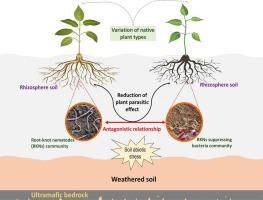Elucidating the suppressive role of native bacterial traits against root-knot nematodes to control plant-parasitic effect in serpentine hostile rhizosphere soil
IF 5
2区 农林科学
Q1 SOIL SCIENCE
引用次数: 0
Abstract
Root-knot nematodes (RKNs) pose a major threat to natural vegetation and agricultural productivity worldwide. The plant rhizosphere harbors rich and diverse bacterial communities, however, the role of native rhizobacterial traits in plant protection against RKN parasitism remain unclear. This study investigated how rhizobacteria associated with serpentine-adapted plants suppress RKNs under extreme edaphic stress. Results showed that serpentine soil factors and RKN presence altered bacterial community assembly, and edaphic stress intensified RKN parasitic effects. Increased bacterial diversity and abundance were strongly correlated with a reduction in the abundance of RKN. Key bacterial taxa such as Pseudomonas putida, P. parafulva, P. straminea, and Burkholderia gladioli were enriched and linked with the suppression of Meloidogyne javanica and M. ethiopica. Functional pathways related to chitin degradation, chorismate metabolism, L-arginine biosynthesis, teichoic acid biosynthesis, and catechol degradation to beta-ketoadipate were significantly enriched and linked to plant protection against RKN infections and parasitic effects (**p < 0.01; *p < 0.05) in rhizosphere soils. Structural equation modeling (SEM) showed that heavy metals (HMs) and nutrients accounted for 78 % and 86 % of the variance (R2 = 0.78; R2 = 0.86) in rhizobacterial and RKN communities, respectively. Canonical correspondence analysis (CCA) revealed that HM stress and nutrient availability influenced rhizobacteria–RKN interactions, while pH, moisture content (MC), and electrical conductivity (EC) significantly regulated their composition and distribution. These findings highlight the ecological importance of native rhizobacteria in mitigating plant nematode parasitism and offer a sustainable strategy for managing nematode stress in challenging soil ecosystems.

阐明原生细菌性状对根结线虫的抑制作用,以控制蛇形有害根际土壤中的植物寄生效应
根结线虫(RKNs)对世界范围内的自然植被和农业生产力构成重大威胁。植物根际蕴藏着丰富多样的细菌群落,然而,原生根际细菌性状在植物抗RKN寄生中的作用尚不清楚。本研究研究了与蛇纹石适应植物相关的根杆菌如何在极端土壤胁迫下抑制RKNs。结果表明,蛇形土壤因子和RKN的存在改变了细菌群落组合,土壤胁迫加剧了RKN的寄生效应。细菌多样性和丰度的增加与RKN丰度的降低密切相关。关键细菌类群如恶臭假单胞菌、副假单胞菌、菌株假单胞菌和剑兰伯克氏菌被富集,并与javanmeloidogyne和埃塞俄比亚假单胞菌的抑制有关。根际土壤中几丁质降解、choris酸代谢、l -精氨酸生物合成、胆酸生物合成和儿茶酚降解β -酮己二酸相关的功能通路显著丰富,并与植物抗RKN感染和寄生效应相关(**p < 0.01; *p < 0.05)。结构方程模型(SEM)表明,重金属(HMs)和营养物质分别占根菌群落和RKN群落变异量的78%和86% (R2 = 0.78; R2 = 0.86)。典型对应分析(CCA)表明,HM胁迫和养分有效性影响根瘤菌- rkn相互作用,pH、水分含量(MC)和电导率(EC)显著调节其组成和分布。这些发现强调了原生根杆菌在减轻植物线虫寄生方面的生态重要性,并为在具有挑战性的土壤生态系统中管理线虫胁迫提供了可持续的策略。
本文章由计算机程序翻译,如有差异,请以英文原文为准。
求助全文
约1分钟内获得全文
求助全文
来源期刊

Applied Soil Ecology
农林科学-土壤科学
CiteScore
9.70
自引率
4.20%
发文量
363
审稿时长
5.3 months
期刊介绍:
Applied Soil Ecology addresses the role of soil organisms and their interactions in relation to: sustainability and productivity, nutrient cycling and other soil processes, the maintenance of soil functions, the impact of human activities on soil ecosystems and bio(techno)logical control of soil-inhabiting pests, diseases and weeds.
 求助内容:
求助内容: 应助结果提醒方式:
应助结果提醒方式:


